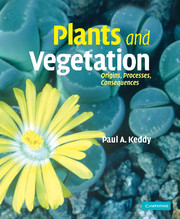Book contents
- Frontmatter
- Contents
- Preface
- Acknowledgements
- Chapter 1 Plants and the origin of the biosphere
- Chapter 2 Description of vegetation: the search for global patterns
- Chapter 3 Resources
- Chapter 4 Stress
- Chapter 5 Competition
- Chapter 6 Disturbance
- Chapter 7 Herbivory
- Chapter 8 Positive interactions: mutualism, commensalism, and symbiosis
- Chapter 9 Time
- Chapter 10 Gradients and plant communities: description at local scales
- Chapter 11 Diversity
- Chapter 12 Conservation and management
- Questions for Review
- References
- Index
- References
Chapter 10 - Gradients and plant communities: description at local scales
- Frontmatter
- Contents
- Preface
- Acknowledgements
- Chapter 1 Plants and the origin of the biosphere
- Chapter 2 Description of vegetation: the search for global patterns
- Chapter 3 Resources
- Chapter 4 Stress
- Chapter 5 Competition
- Chapter 6 Disturbance
- Chapter 7 Herbivory
- Chapter 8 Positive interactions: mutualism, commensalism, and symbiosis
- Chapter 9 Time
- Chapter 10 Gradients and plant communities: description at local scales
- Chapter 11 Diversity
- Chapter 12 Conservation and management
- Questions for Review
- References
- Index
- References
Summary
Vegetation description. Profile diagrams. Block diagrams. Forest site types. Vegetation cover types. Vegetation templates. Summary displays. Indirect gradient analysis. Use and abuse of multivariate models. Measurement of similarity. Ordination techniques. Sea cliff vegetation. Riverine wetlands. Functional summaries. Vegetation classification. Phytosociology. Site classification and land management. Direct gradient analysis. The importance of null models and tests. Salt marsh zonation. Freshwater shoreline zonation. Emergent wetland zonation. On the existence of communities: the null model perspective.
Introduction
Early explorers encountered plant species and vegetation types that were entirely unknown in Europe. Some of the methods for describing patterns in vegetation at the global scale were introduced in Chapter 2, but the description of vegetation at smaller than global scales continues to be a challenging issue in plant ecology. Accurate description is essential for both scientific research and conservation.
In the most basic way, accurate description is a first step in any scientific inquiry. Even large experiments need description – the selection of each dependent variable requires a decision about which properties are most appropriate to describe the possible responses of manipulated communities. In the case of conservation applications, accurate description provides methods to divide landscapes into ecologically similar units, which can then guide the selection of new protected areas, or suggest those areas most appropriate for urban development. Further, once each vegetation unit in a landscape is delineated, it is then possible to select the most appropriate management activities such as grazing, logging, or reforestation.
- Type
- Chapter
- Information
- Plants and VegetationOrigins, Processes, Consequences, pp. 457 - 501Publisher: Cambridge University PressPrint publication year: 2007



